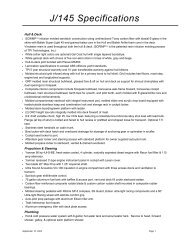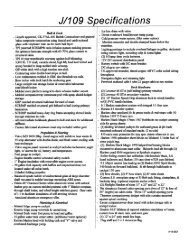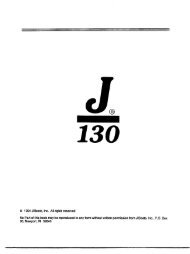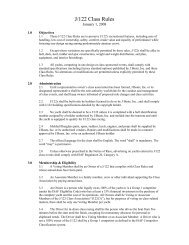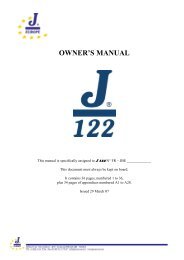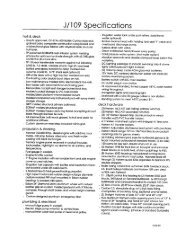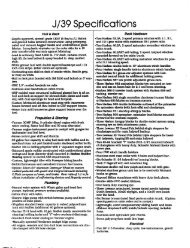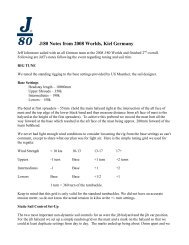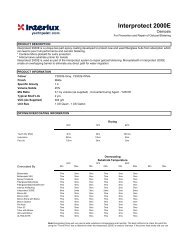J105 Owner Manual 2012.pdf - J/Owners
J105 Owner Manual 2012.pdf - J/Owners
J105 Owner Manual 2012.pdf - J/Owners
Create successful ePaper yourself
Turn your PDF publications into a flip-book with our unique Google optimized e-Paper software.
J/105 <strong>Owner</strong> Guide ...................................................................................................................................................................................................................................................... 48 <br />
Rigging <br />
Standing Rigging -‐ The general rule of thumb from Hall Spars is that standing rigging (whether <br />
wire or rod) should be replaced every 10 years, unless excess strain due to hard ocean sailing <br />
shortens this life. Fatigue can be in any form-‐ sailing in extreme wind conditions, unnecessary <br />
flogging of loose leeward shrouds, corrosive environment. Any signs of a broken wire strand(s) <br />
indicate immediate replacement is necessary. Otherwise keep a close look out for corrosion or <br />
cracking in the swage fittings and turnbuckle threads. In southern coastal areas, with the high <br />
salinity and year round warm weather, rigging must sometimes be replaced every 5 years. Fresh <br />
water sailed boats will generally have a longer rigging life, but are still subject to fatiguing after <br />
years of stress. <br />
Headstay -‐ The top of the headstay (wire or rod) should be checked to make sure it’s not bent. <br />
The fasteners and the top of the headstay foil should also be routinely checked. <br />
Clevis pins -‐ More rigging and spar mishaps are caused by clevis pins backing out, than perhaps <br />
any other culprit. If the clevis pins are semi-‐permanent (only removed a few times per year), <br />
then use appropriate sized cotter pin and fully bend them back around the clevis pin. Then cover <br />
with clear sealant rather than tape so that they are visible. <br />
Running rigging -‐ suffers the greatest wear and tear (chafing primarily) and should be checked <br />
frequently for wear, particularly high load lines like main and jib halyards and jib sheets. <br />
Spars <br />
Spar life can vary, but Hall Spar’s general rule is the mast should be replaced every 20 years. <br />
Frequently check your spar for problems. Spars break more often than not by a failure in the <br />
standing rigging, but there are some specific areas to keep an eye out for: <br />
Deck Area -‐ The mast section at the partners (where the mast passes through the deck) is usually <br />
subject to the most fatigue over time. This is due to the rig getting set up with pre-‐bend, then <br />
pulling on lots of backstay tension, and the constant flexing of the spar over many years. The <br />
best prevention is a good set of mast wedges or the Spartite mast wedge system. Unchecked <br />
movement at the deck can significantly shorten the life of the spar. Be especially careful about <br />
drilling any holes in the mast near the deck, and periodically inspect any holes in the area to <br />
make sure, there are no cracks developing. Any holes must be round or have rounded corners. <br />
Spreader Tips -‐ these should be untaped and inspected annually. Seizing wire should be redone <br />
annually so that the shrouds will never “pop” out of the spreader tip. Use spreader chafe covers <br />
that won’t collect water. <br />
Rig Tuning -‐ to provide not only the best performance but also a longer mast life, it’s very <br />
important to properly “tune the mast.” Tuning means adjusting the shroud tension so that the <br />
top of the mast is centered over the boat, and such that the mast is in column or straight as you <br />
site up the mast groove on the aft side. Proper tuning for all conditions usually means <br />
maintaining enough tension on the shrouds so that they do not go completely slack on the <br />
leeward side while sailing. Many successful one-‐design classes have tuning guides published and <br />
provided by sailmakers. Some of these may suggest very loose settings on the shrouds for better <br />
light air performance. Care should be taken by owners to avoid sailing in windy conditions with <br />
light air shroud settings. This may significantly shorten the life of the mast and lead to breakage.



